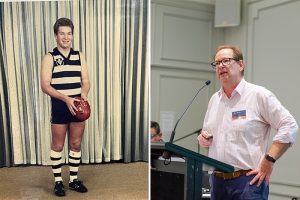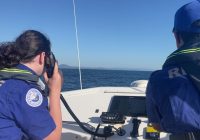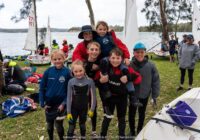Counting kangaroos in the dusty wilds of northern Victoria is far from a typical apprenticeship for those charged with conserving and managing Australia’s most iconic marine environments.
But, as his Reef Authority colleagues will cheerfully argue, Ian Walker is perhaps not a typical marine park manager.
At the Reef Authority he is responsible for overseeing some of organisations most significant work programs including the world-first Douglas Shoal remediation project, the organisation’s flagship Outlook Report, and the much-anticipated redevelopment of Townsville’s Great Barrier Reef Aquarium.
His work in conservation management has taken him from the arid plains of Victoria’s Mallee country to Western Australia’s resource-rich Pilbara region, and all the way to the corridors of power in the Australian Capital Territory.
But few know that Ian’s storied career can be traced back to the well-worn turf of Geelong’s Kardinia Park, where he was once a rising star of the Geelong Football Club.
“I did play AFL,” Ian admits, somewhat reluctantly, “with Geelong in the under 19s, and in the reserves so yes, I spent a bit of time kicking the leather around the field.

“I actually grew up around that area. Those iconic images of the Great Ocean Road and the Twelve Apostles were my backyard in a sense and that was essentially my first connection to nature.”
This connection would eventually lead to a university degree in natural resource management, and Ian’s first official posting with Parks Victoria, including a stint counting kangaroos in Victoria’s Mallee country.
“I think most people that work in environmental management and protection have a unique passion that is often triggered by something in their youth,” Ian says.
“For me, it was a childhood memory from Port Phillip Bay. I was four or five years old at the time and I remember seeing, what I thought was, the most humongous hammerhead shark. It was probably only six feet long, but it just resembled this prehistoric creature that I had to know more about and sparked an interest in nature and marine environments that, thankfully, I’ve never lost.
“It’s funny how those memories remain and come back in different ways so many years later.”
For Ian, that first ‘full circle’ moment culminated in the early 2000s when he played a pivotal role in establishing Victoria’s 13 marine national parks, and 11 marine sanctuaries, that now protect more than 5.3 per cent of Victoria’s marine waters, including plants and animals, from damaging extractive activities like commercial fishing and fossil fuel exploration.
He has since worked closely with Traditional Owners in Western Australia to facilitate co-management of the World Heritage-nominated Murujuga Cultural Landscape, as well leading the development of the Ngootyoong Gunditj Ngootyoong Mara South West Management Plan – Victoria’s first joint management plan which helps to protect over 130 parks, reserves and Indigenous Protected Areas in south-west Victoria, in line with the cultural values of the Gunditjmara Traditional Owners. It incorporates the Budj Bim Cultural Landscape which, like the Great Barrier Reef, is inscribed on UNESCO’s World Heritage List, for its Outstanding Universal Value.
It was these experiences, coupled with time working with the Ngunnawal people to create the Namarag nature space within the Molonglo River Reserve that were instrumental in his appointment to help develop and lead one of the Reef Authority’s most ambitious projects to date.
The proposed new Southern Plan of Management which will take in the area from Midge Point, approximately 100km north of Mackay, to the southern boundary of the Marine Park just north of Bundaberg, represents a new chapter in sustainable marine park management.
The plan is a statutory tool that will sit underneath the existing Zoning Plan, and will aim to further safeguard the ecological, heritage, social, aesthetic and cultural values of the Great Barrier Reef Marine Park while allowing for multiple uses in a sustainable manner, reducing conflicts among users, and helping to strengthen Reef resilience.
And for the first time, Ian says proudly, the plan is being jointly developed with Queensland Parks and Wildlife Service, and the Traditional Owner groups from across the southern Great Barrier Reef – including representatives from the Yuwibara, Darumbal, Woppaburra and Port Curtis Coral Coast Traditional Owners – who have cared for the Reef for millennia.
“It’s a really great step in honouring and recognising 60,000-plus years of knowledge, experience and connection that our Traditional Owner partners bring to the table,” he says.
“In some of my previous roles I have seen examples of where tradition and the ability to communicate in language has been lost so initially, as part of this project, we wanted to hear from the Traditional Owners and ensure firstly that they are comfortable sharing their stories with us moving forward.”
Traditional Owner coordinators were employed to help lead the first phase of public consultation, which included public open days across the catchment area and online surveys.
“We’ve now collated the feedback from almost 200 submissions received during the first phase of publication consultation held earlier this year – from 19 March through to 19 June – during which any and all interested members of the public were encouraged to have their say on what they value most of the Reef; what activities they like to do on the Reef; any questions or concerns they have, and so on,” Ian says.
Feedback from these submissions will be used to help develop the Draft Southern Plan of Management, which will then be released for second round of public consultation.
“We obviously have significant expertise within the Reef Authority, as do our Queensland Government colleagues, and we’re also working with other tourism and research representatives, so it’s a very thorough and significant process to ensure the plans works in everyone’s interests while achieving its inherent goals,” Ian says.
There are currently four existing plans of management, geared predominantly towards to the central and northern areas of the Marine Park around Whitsundays, Hinchinbrook, Cairns and Port Douglas marine areas. The existing plans provide additional protection for vulnerable species like dugongs, turtles and seabirds including regulations around the use of motorised crafts, vessel size, and visitor numbers.
However, Ian says, the new Southern Plan of management, which will cover a staggering 42 per cent of the entire Marine Park, and includes 70 per cent of all sea turtle nesting sites on the Great Barrier Reef, will holistically address a broad range of issues.
“There currently is no plan of management for the southern area of the Marine Park, so it is essentially a greenfield location and allows us to approach elements of it somewhat differently to how our predecessors may have in the past,” he says.
“That starts by partnering with the Traditional Owner to ensure that the Marine Park is managed in line with cultural values coupled with future sustainability and protection. The Great Barrier Reef is Australia’s greatest natural wonder, and a cultural icon, and we want to make sure it remains that way for everyone to enjoy, now and into the future.”
For more information and to stay up to date go to Southern Plan of Management







